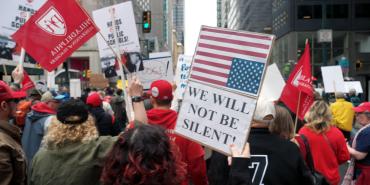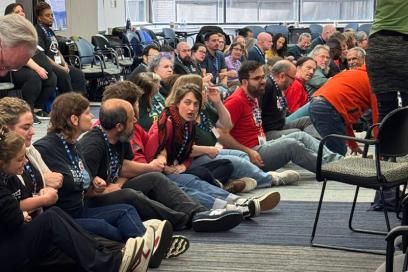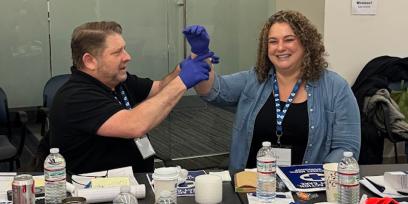AFT members were hungry for action at the mass mobilization training held at AFT headquarters May 9, where leaders from our higher ed affiliates gathered to build skills that will meet the moment. As threats to democracy and public higher education continue to grow, participants came to learn how to organize peaceful, nonviolent actions to defend their institutions, their students and their values—and to stand up for the communities they serve.
In a frank discussion, workshop leaders described the current landscape as grim. Democratic norms are being undermined—from attacks on academic freedom and the media, to crackdowns on dissent. Participants explored how to respond with people-powered resistance rooted in solidarity, justice and nonviolence.
Drawing from history and international examples, they emphasized this key point: When democracy is threatened, collective action can make the difference. And unions, which are built on organizing and solidarity, are uniquely positioned to lead.
Scale it up
Workshop participants dove right in with techniques for building momentum and engagement: mapping potential participants and supporters, networking with allies and partners, and distributing engagement at different levels so everyone can be included. “Mass mobilization” can sound intimidating, said Jackie Daugherty, a trainer from the AFT’s Union Labor Institute, but it’s just a matter of “casting a bigger net” beyond the usual union parameters and into the larger community of faith organizations; service clubs; and, in higher education, students, alumni, sympathetic members of boards of trustees, donors, parents and other unions.
Reviewing layers of planning and execution, participants talked about all the details involved in organizing an action, including arranging for (and wrangling) speakers, ordering porta-potties and water, and following up with allied groups.
Then they tackled a case study, coming up with creative ways to hit back in this realistic scenario: A theoretical university board has voted to remove all courses and programs related to race and gender and is requiring administrative review of all syllabuses and books before distribution. The board vote precedes an imminent vote on a legislative bill that could abolish the university’s office of minority affairs and eliminate diversity, equity and inclusion from courses, objectives, student learning outcomes, exams, assignments and other programs. Even individual faculty are threatened.
Ideas about how to strike back flew across the room as small groups worked out solutions and shared similar situations and reactions from their own campuses. Among their ideas: visit legislative offices, pack committee hearings, hold a press conference on the day of the hearing, generate written testimonies, hold teach-ins and draw on affinity groups.
Taking to the streets
Planning turned to action when workshop participants considered nonviolent protests. Resistance is far more than clever slogans and signs, though the session did cover these. Participants also practiced linking arms to demonstrate solidarity and learned about how to handle arrests should they occur.
For those organizing an event or attending a large event as an affinity group, the training offered guidelines like preparing marshals and safety leads, arranging for medical and jail support (should there be arrests) and planning how to communicate during the event.
Much of the advice was about how to stay safe. A three-hour street medic training gave participants the skills they would need to care for people who might be hurt during an event—and culminated in an Adult First Aid certificate and a backpack filled with street medic supplies. Participants practiced with pressure bandages and tourniquets and worked together to move “wounded protesters” safely. They learned about how to flush pepper spray from eyes; deal with tear gas; address head, bone, joint and muscle injuries; handle shock; and more.
Commitment
Learning the skills it takes to level up to this kind of resistance shows a real commitment to the cause—on top of the foundational work our unions do every day. But AFT members at the training were ready.
“If we don’t do this, we won’t have the regular business of the union,” said Bethany Gizzi, president of the Faculty Association of Monroe Community College in Rochester, N.Y. “There’s not going to be a tomorrow if we don’t do this today,” agreed Roberta Elins, president of the United College Employees of the Fashion Institute of Technology in New York.
“We’re hitting this critical point where all bets are off,” said Katie Rodger, president of University Council-AFT, the faculty and librarian union at the University of California. Even contingent faculty, whose job security is more at risk, are ready to take a stand. “We all feel it.”
“To be honest, I’m terrified,” said Mason Richards, a filmmaker and adjunct faculty at Emerson College’s Los Angeles campus and president of Emerson Los Angeles AAUP/AFT. He said he came to the training to quell that fear and experienced a level of activism and knowledge there he found inspiring.
“I was so heartened when I heard AFT recognize that we can’t just keep calm and carry on,” said Rebecca Gordon, who teaches about issues of justice and collective responsibility at the University of San Francisco, where she is a member of the USF Part-Time Faculty Association.
The AFT will continue to offer mass mobilization workshops at divisional conferences and other events.
[Virginia Myers]



